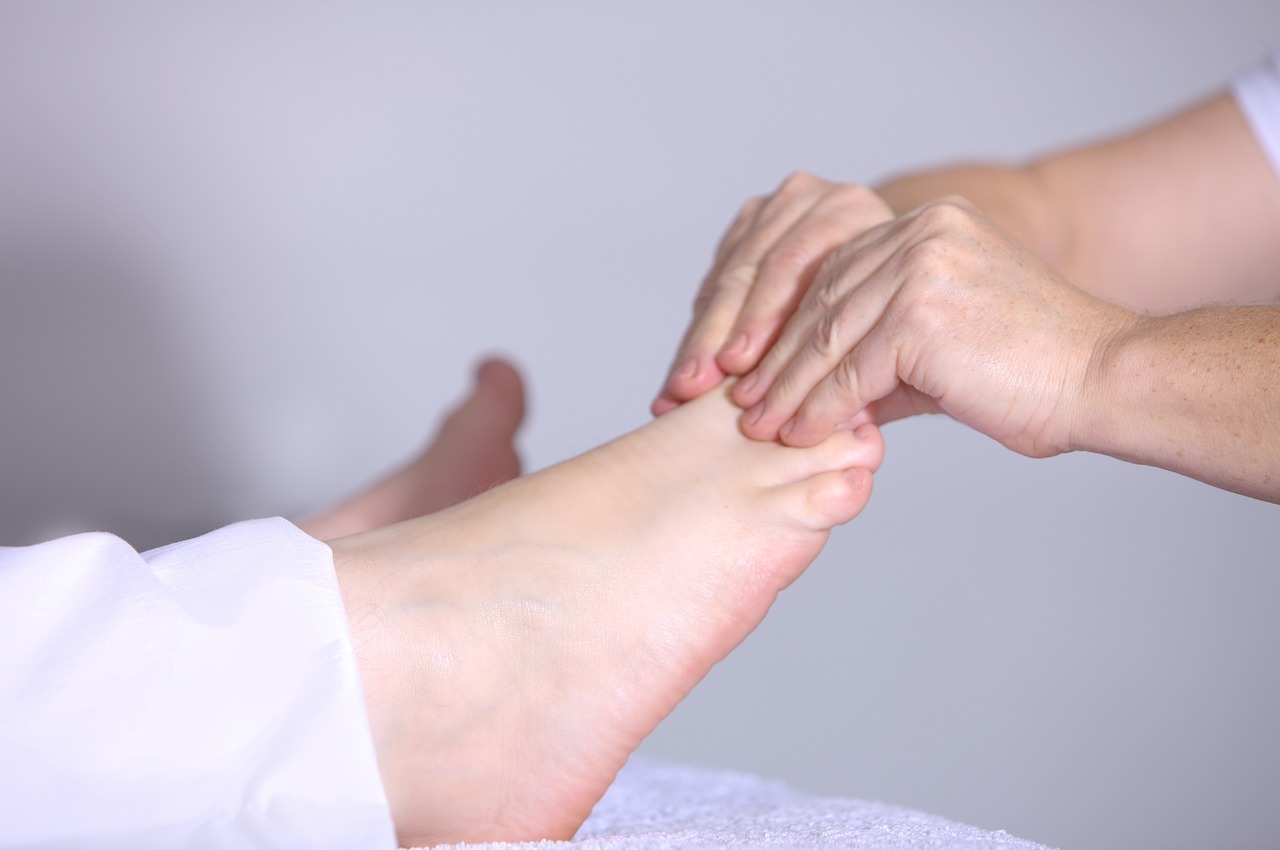Effective home remedies to cure your diabetic foot pain. I’ve struggled with diabetic neuropathy’s pain myself. It’s frustrating and uncomfortable. The tingling, burning, and aching make simple tasks hard. But, there’s hope in natural home remedies.
This guide will show you eight home remedies for diabetic foot pain. We‘ll cover the RICE strategy, warm water soaks, massage, and herbal supplements. These solutions are safe, accessible, and can improve your life. Say goodbye to foot pain and hello to better mobility and comfort.
Key Takeaways
- Effective home remedies can provide relief for diabetic foot pain and neuropathy symptoms.
- The RICE strategy (Rest, Ice, Compression, Elevation) can help reduce inflammation and swelling.
- Warm water foot soaks and gentle massage techniques can improve circulation and ease discomfort.
- Stretching, low-impact exercises, and herbal remedies may help manage nerve pain and promote overall foot health.
- Lifestyle modifications, such as stress management and dietary changes, can also contribute to better diabetic foot care.
Understanding Diabetic Foot Pain
Causes and Complications of Diabetic Neuropathy
Diabetes can cause nerve damage called diabetic neuropathy. High blood sugar levels over time lead to this nerve damage. It can cause numbness, tingling, and sharp pain that makes daily life hard.
Poor blood circulation makes diabetic neuropathy worse. This combination increases the risk of diabetic foot complications like ulcers and amputation. Regular check-ups and early detection are key to prevent these severe outcomes and manage diabetic foot pain well.
| Causes of Diabetic Neuropathy | Complications of Diabetic Neuropathy |
|---|---|
|
|
Managing diabetes and keeping blood sugar levels healthy are key to prevent diabetic neuropathy and foot problems. By understanding the causes and taking action, people with diabetes can reduce diabetic foot pain and keep their feet healthy.

RICE Strategy for Reducing Inflammation
The RICE technique (Rest, Ice, Compression, and Elevation) is great for diabetic foot pain. It’s simple yet powerful. It helps with the discomfort and swelling from diabetic neuropathy.
Rest is the first step. Let your feet rest and avoid too much activity. This reduces stress and helps them heal. It means taking breaks from standing or walking.
Ice therapy is key too. Cold packs or ice wrapped in a towel can help. It numbs the pain and reduces swelling. Use it for 15-20 minutes, several times a day, especially in the first 24-48 hours.
Compression helps too. Use an elastic bandage or compression stockings. They limit swelling and support the injured area. This is good for swelling in the feet or ankles.
Elevation is also important. Raise your feet above your heart to drain excess fluid. This reduces swelling and pain. Use pillows or a wall to prop your feet up.
Using the RICE technique can help manage inflammation and relieve pain. Always talk to your healthcare provider for personalized advice. They can help with any underlying issues or complications.
| RICE Technique | Benefits |
|---|---|
| Rest | Reduces stress on the affected area and promotes healing |
| Ice | Decreases inflammation, numbs pain, and constricts blood vessels |
| Compression | Limits swelling and provides additional support to the injured area |
| Elevation | Promotes drainage of excess fluid, reducing pain and swelling |
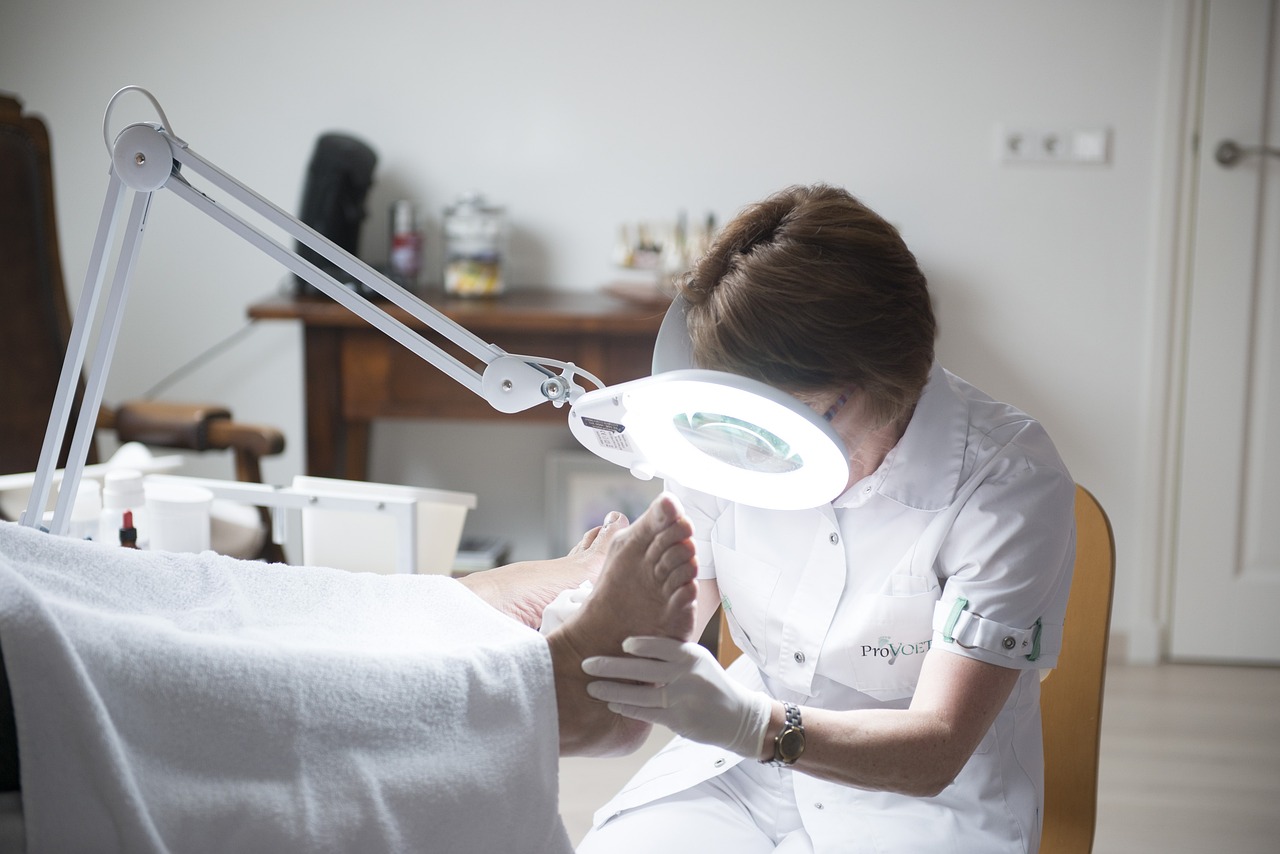
Following the RICE technique can offer natural relief for diabetic foot pain. It makes daily life more comfortable and manageable.
Warm Water Foot Soaks
Benefits and Precautions
Warm water foot soaks can ease diabetic foot pain. The warm water boosts blood flow and relaxes muscles. Adding Epsom salt makes it even more soothing, thanks to its anti-inflammatory effects.
But, it’s important to be careful with diabetic feet in water. Too much time in water can dry out the skin, making it crack and more prone to infection. To avoid this, soak for only 10-20 minutes. Use talcum powder to dry off after soaking. Also, don’t put lotion between your toes, as it can cause bacteria to grow.
By following these tips, people with diabetes can enjoy better blood flow and less inflammation. This helps reduce the risks of soaking their feet in warm water.
| Benefits of Warm Water Foot Soaks | Precautions to Take |
|---|---|
|
|

“Incorporating warm water foot soaks into a comprehensive foot care routine can help individuals with diabetes enjoy the benefits of improved blood flow and reduced inflammation, while mitigating the potential risks.”
By following these guidelines and incorporating warm water foot soaks into a comprehensive foot care routine, individuals with diabetes can enjoy the benefits of improved blood flow and reduced inflammation, while mitigating the potential risks.
Foot Massage Techniques
If you have diabetic neuropathy, foot massages can help a lot. Studies show they can cut down on pain. This is good news for people with diabetes, as up to 50% of them are affected.
Foot massages boost blood flow, relax muscles, and help you relax. Soft, circular strokes can ease foot pain and boost your mood. You can do it yourself or ask someone to help. Adding foot massages to your daily routine can help manage diabetic neuropathy symptoms.
Techniques for Self-Foot Massage
- Use marbles in warm water: Roll your feet over a handful of smooth marbles in a basin of warm water to apply targeted pressure.
- Roll a tennis ball: Sit down and roll a tennis ball under your feet, applying gentle pressure as you go.
- Rub with nongreasy lotion: Apply a small amount of unscented, nongreasy lotion to your feet and gently rub in circular motions.
Techniques for Receiving a Foot Massage
- Effleurage: The therapist uses long, gliding strokes to warm up the muscles and improve circulation.
- Tapotement: The therapist uses tapping or percussion techniques to stimulate the nerves and promote relaxation.
When getting a foot massage, tell the therapist about your diabetic neuropathy. They should avoid any open wounds or sensitive areas.
| Benefit | Evidence |
|---|---|
| Reduced discomfort from diabetic peripheral neuropathy | A 2022 study found that foot massage therapy can significantly reduce discomfort from this condition. |
| Improved relaxation and emotional well-being | Research from 2010 and 2018 suggests that massage therapy can aid in dealing with physical and mental health challenges, reduce anxiety, and improve vital signs. |
| Pain management | A 2016 review recommended healthcare professionals to suggest massage therapy as an option for pain management. |
Foot massages can be a great addition to managing diabetic neuropathy. But, always talk to your doctor first. Keeping your blood sugar in check is also key to managing this condition.
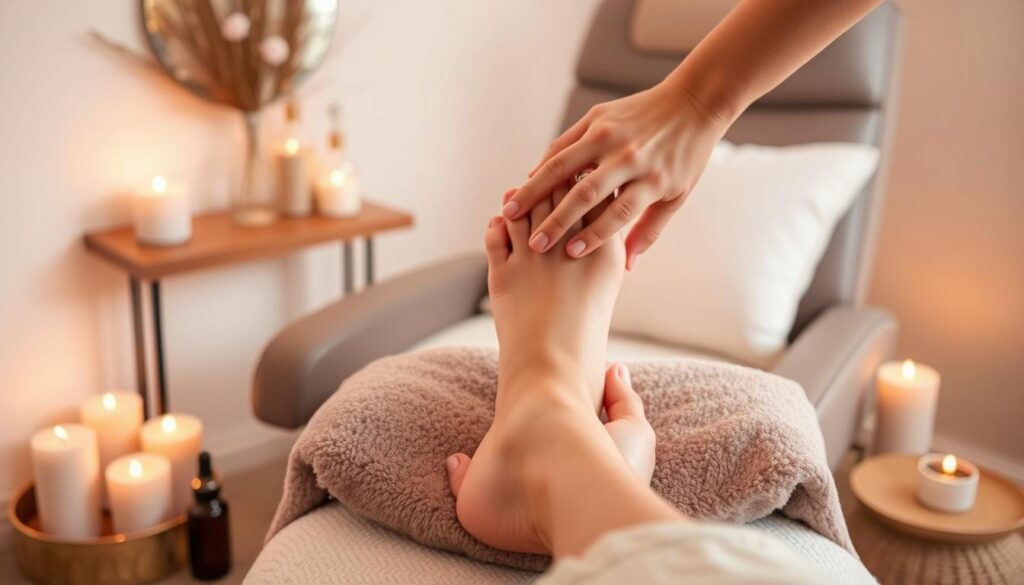
“Integrating massages into a treatment plan for diabetic neuropathy may alleviate symptoms and provide relief, particularly when done by trained professionals.”
Stretching and Low-Impact Exercises
For those with diabetic foot pain, gentle stretching and low-impact exercises are very helpful. Mild calf and foot stretches can make your feet more flexible and reduce pain. Walking, which is easy on your feet, keeps your heart rate up.
Recommended Routines for Diabetic Foot Pain
Begin your day with simple toe wiggling and circular foot movements while sitting. These small actions can boost flexibility and blood flow in your feet. Add some calf and Achilles tendon stretches to your routine, holding each for 30 seconds.
- Seated Hamstring Stretch: Sit with one leg extended. Gently flex your foot and lean forward to feel the stretch in the back of your thigh. Repeat 3 times per leg.
- Calf Raises: Stand with feet shoulder-width apart and raise up on your toes, lifting your heels off the ground. Hold for 2 seconds, then lower back down. Repeat 10-15 times.
- Ankle Circles: Sit or stand and make circular movements with your feet, going both clockwise and counterclockwise. Complete 10 circles in each direction.
For a low-impact cardio boost, try walking for 30 minutes a day, at least 3 times per week. Start slowly if you’re new to exercise, building up duration over time. Adding balance training exercises like leg and calf raises can also help improve stability and reduce the risk of falls.
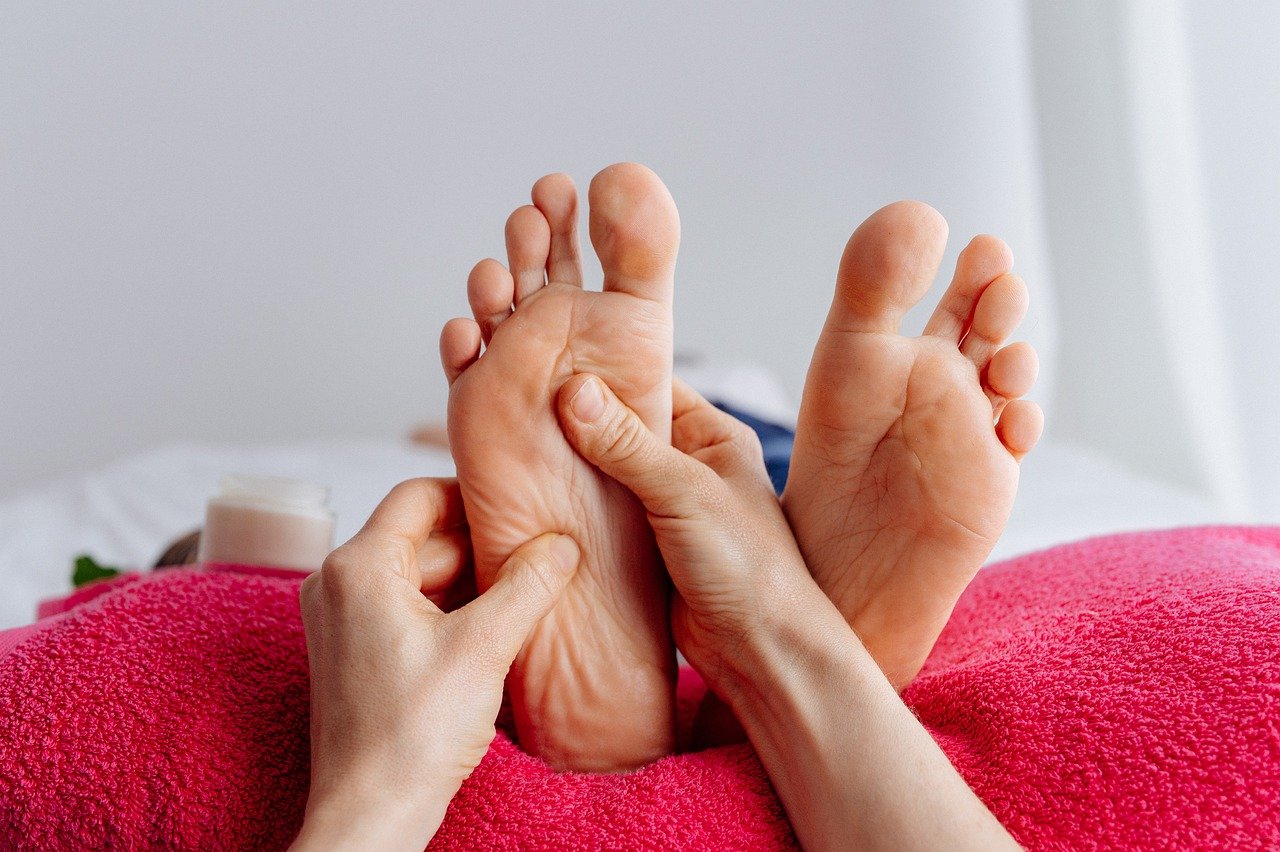
Remember, it’s important to listen to your body and avoid any movements that cause sharp or severe pain. Consistency is key, so make these gentle exercises a regular part of your routine to maintain flexibility and circulation in your feet.
Herbal Remedies and Anti-Inflammatory Ingredients
For those with diabetic foot pain, some herbal treatments and anti-inflammatory ingredients can help. They offer natural relief. Here are some of the most effective options:
- Ashwagandha: This herb has strong anti-inflammatory properties. It can help ease the discomfort of diabetic neuropathy.
- Turmeric: Turmeric’s active compound, curcumin, is a powerful natural anti-inflammatory. It’s great for managing diabetic foot pain.
- Paneer Dodi: Known as Costus, this herb is used in traditional medicine. It treats various inflammatory conditions, including diabetic nerve pain.
- Ginger: Ginger’s compounds have strong anti-inflammatory effects. They can help relieve diabetic foot discomfort.
Also, drinking small amounts of bitter gourd juice can help control blood sugar levels. This is key for managing diabetic neuropathy and its foot pain. These natural remedies address the root causes of diabetic foot pain. They also promote overall foot health.

“Incorporating these herbal treatments and anti-inflammatory ingredients into your daily routine can be a game-changer. It helps manage diabetic foot pain and promotes overall foot wellness.”
Contrast Therapy: Hot and Cold Treatments
For those with diabetic foot pain, contrast therapy can help. It uses hot and cold water to ease discomfort and aid healing.
Ice helps by numbing pain. But, if ice is too hard to handle, try a contrast bath. This involves switching between cold and warm water several times. It’s a good way to get relief from diabetic foot pain.
Studies show contrast therapy can lessen muscle fatigue and pain. It also helps with swelling and improves joint movement. A 2018 study found it boosts healing by improving blood flow and reducing swelling.
To do a contrast bath, start with warm water (38°C–40°C) for 10 minutes. Then, switch to cold water (8°C–10°C) for one minute. Keep alternating for 30 minutes. This can help with muscle damage and joint stiffness.
But, contrast therapy can also have risks. It might cause burns, increase bleeding, or worsen nerve pain. People with high blood pressure, open wounds, or diabetes should talk to their doctor first.
Contrast therapy is a useful tool against diabetic foot pain and neuropathy. By switching between hot and cold, you can find relief and support healing. Always be careful and get medical advice if needed.
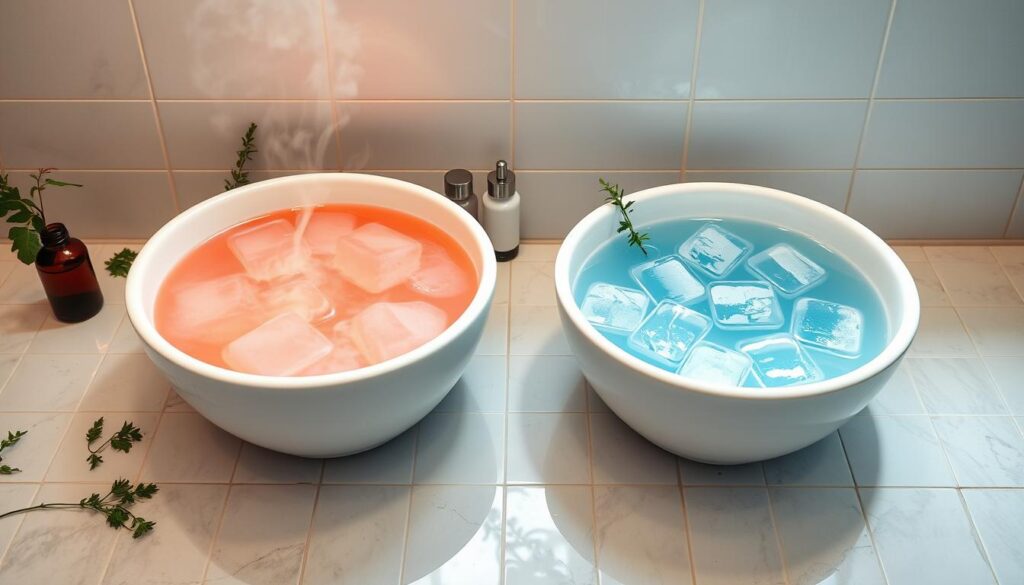
| Benefit | Evidence |
|---|---|
| Reduces muscle fatigue, spasms, pain, and swelling | Research has shown contrast therapy can reduce these symptoms following intense exercise. |
| Improves joint range of motion and mobility | Contrast therapy may help improve the range of motion and functional mobility of joints such as the knee, elbow, or hands. |
| Promotes tissue healing | A 2018 study confirmed that contrast therapy increases tissue oxygenation and decreases swelling and edema. |
| Eases arthritis pain and stiffness | A 2022 review suggests contrast therapy is more effective in reducing arthritis pain and stiffness than a hot bath alone. |
| Reduces severe nerve pain | A 2022 case study reported that contrast therapy led to a greater than 50% reduction in severe nerve pain. |
Lifestyle Modifications for Diabetic Foot Care
Managing diabetes and keeping your feet healthy are closely linked. Keeping your blood sugar in check, eating well, and drinking plenty of water can help. Quitting smoking also boosts blood flow and foot health.
Choosing the right shoes is also key. Stay away from shoes that are too tight or don’t support your feet well. Instead, pick shoes that fit right, are comfy, and support your arches.
- Wear shoes that are the right size and fit with enough space, cushion, and solid arch support.
- Inspect your feet daily for any signs of changes, such as dry skin, blisters, cuts, or discoloration.
- Maintain good toenail care by trimming them straight across and avoiding cutting into the corners.
- Moisturize your feet regularly to prevent dryness and cracking, which can increase the risk of infection.
By adopting these lifestyle changes and focusing on foot care, you can manage your diabetes better. Don’t forget to see your healthcare provider regularly. This helps catch any issues early and ensures you get the right treatment.
“Preventing foot problems is key for individuals with diabetes. A proactive approach to foot care can go a long way in avoiding serious complications.”

Good foot health is crucial for managing diabetes. By making these lifestyle changes and being careful with your foot care, you can lower the risk of complications. This way, you can enjoy healthier, happier feet.
Effective Home Remedies to Cure Your Diabetic Foot Pain
Living with diabetes can be tough, but there are ways to ease foot pain at home. Natural treatments and home care can help manage diabetes complications. This way, people with diabetes can take charge of their foot health and find relief.
The RICE method (Rest, Ice, Compression, Elevation) is a great home remedy. It helps reduce swelling and pain in the feet. Soaking your feet in warm water with Epsom salt can also help heal and soothe nerve pain. Foot massages, with gentle kneading, can improve blood flow and relax muscles.
Exercising, like walking or swimming, can strengthen your feet and legs. This supports your overall foot health. Turmeric, with its anti-inflammatory properties, is a natural way to ease pain. Alternating between hot and cold treatments can also help by improving blood flow.
Changing your lifestyle can also help with diabetic foot care. Quitting smoking, staying at a healthy weight, and managing stress can make a big difference. By tackling the root causes of diabetic neuropathy, you can find effective home remedies for your foot pain.
“Incorporating a combination of these home remedies can be a powerful tool in managing the complications of diabetes and finding relief from diabetic foot pain.”
While medical treatments are key, these natural methods can also help. They can ease discomfort and manage diabetes complications. By being proactive in foot care, people with diabetes can manage their condition better and improve their well-being.
Stress Management and Relaxation Techniques
Living with diabetic neuropathy can be tough. But, using stress reduction for diabetic neuropathy methods daily can help a lot. Stress can make pain worse, so managing it is key for diabetic foot pain.
Mindfulness, Deep Breathing, and Hobbies
Mindfulness and meditation for pain management can calm your mind and lower stress. Doing deep breathing exercises for a few minutes a day can help your heart rate and blood pressure. Enjoying hobbies like reading, gardening, or music can also help with relaxation techniques to ease diabetic foot pain.
Biofeedback uses sensors to measure and give feedback on your body’s functions. It can help with migraine pain, epilepsy, high blood pressure, and more. Adding biofeedback to your stress management can be very effective for diabetic neuropathy pain.
Yoga, massage, and tai chi can also reduce stress and help with chronic pain. Essential oils like rosemary, lavender, and peppermint can be used to help relieve pain too.
By using different stress reduction for diabetic neuropathy methods every day, you can lessen diabetic foot pain. This can also improve your overall health and well-being.
When to Seek Professional Medical Attention
Home remedies can help with diabetic foot pain, but some signs need a doctor’s help right away. Look out for persistent swelling, soreness that lasts weeks, and unbearable pain. Also, watch for signs of infection like redness, warmth, or fever.
Diabetes can cause nerve damage and poor blood flow, leading to serious foot issues. Ignoring these problems can lead to foot ulcers, infections, and even amputation. Regular check-ups and early detection are key to managing diabetic foot problems.
Some key signs that your diabetic foot pain requires medical attention include:
- Persistent swelling or soreness lasting more than a few weeks
- Unbearable pain that interferes with daily activities
- Symptoms of infection, such as redness, warmth, or fever
- Deep, red, puffy, or warm-to-touch wounds
Don’t wait until your diabetic foot problems get worse. Seek professional medical care quickly to address the issues and prevent severe complications. Your health and well-being are too important to ignore the signs that it’s time to see a doctor.
“Approximately 15 percent of patients with diabetes develop a diabetic foot ulcer, and 6 percent of those who develop a foot ulcer get hospitalized due to infection or complications.”
Conclusion
This article talked about home remedies for diabetic foot pain. These include the RICE strategy, warm water foot soaks, and foot massages. Stretching exercises, herbal treatments, and contrast therapy were also mentioned.
Lifestyle changes and stress management are key too. These natural methods can help with diabetic neuropathy pain. Medical treatments are important, but these home remedies can also help.
Regular foot checks and good sugar control are vital. Proper foot care and the right shoes are also important. They help prevent and manage diabetic foot pain.
By using both home care and medical treatment, people can manage their foot pain better. This approach helps keep feet healthy for a long time.
In short, the summary of effective home remedies for diabetic foot pain in this article is helpful. It offers natural ways to deal with this common issue. By adding these methods to their diabetes care, people can better control their condition and live a better life.

